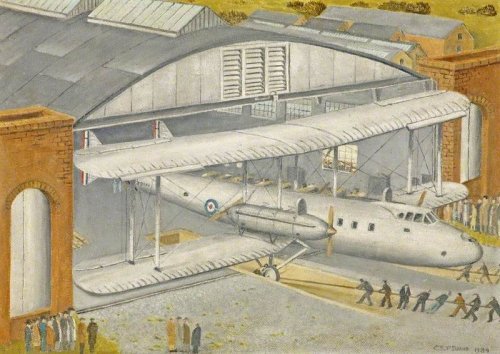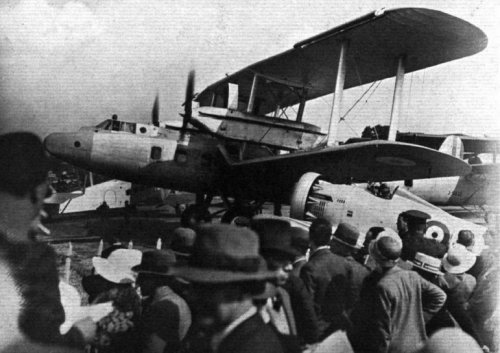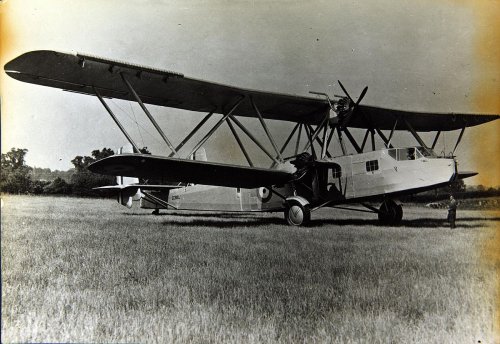blackkite
Don't laugh, don't cry, don't even curse, but.....
- Joined
- 31 May 2007
- Messages
- 8,567
- Reaction score
- 6,742
Hi! Gloster TC.33.
C.16/28 Bomber-transport capable of carrying 30 fully armed troops, or their equivalent in cargo or bombs, for a distance of 1,200 mi (1,900 km) nonstop Gloster TC.33, Handley Page H.P.43, Vickers Type 163, Bristol Type 115, Bristol Type 116
Wikipedia.
https://en.wikipedia.org/wiki/Gloster_TC.33
"The TC.33 was also unusual in having a lower wing of (slightly) greater span than the upper; most unequal span wings had a larger upper wing. The four evaporatively cooled Rolls-Royce Kestrel engines were mounted in two nacelles, each containing a tractor-pusher pair together with their steam condenser and mounted between the wings at the end of the centre section. They were each carried by two vertical struts above the nacelle, complicated strutting below and by further strutting to the lower wing roots. The wide (22 ft 6 in (6.8 m)) split axle undercarriage had vertical legs from the front wing spar at the same point and bracing from the axles to the fuselage.
The fuselage was quite elegant, slender, oval in cross section and smoothly metal skinned. The cockpit was enclosed, but there were open gunners' positions at nose and tail. Like the cockpit, the long main cabin was heated and soundproofed. There was a large hatch in the floor for heavy loads with an integral hoist mounted above it, plus a smaller roof hatch through which loads could be lowered by crane. The biplane tail unit had conventional fabric covered endplate fins and rudders, but the tailplanes were an unusual sesquiplane type. The upper tailplane and elevator was strut mounted above the fuselage and the much narrower chord lower part fixed to the lower fuselage."
Picture source.
http://alternathistory.com/opytniy-bombardirovshchik-transportnyi-samolet-gloster-tc33-velikobritaniya
https://www.artuk.org/discover/artworks/t-c-33-troop-carrier-j9832-rolled-out-of-hucclecote-works-gloucester-62213
C.16/28 Bomber-transport capable of carrying 30 fully armed troops, or their equivalent in cargo or bombs, for a distance of 1,200 mi (1,900 km) nonstop Gloster TC.33, Handley Page H.P.43, Vickers Type 163, Bristol Type 115, Bristol Type 116
Wikipedia.
https://en.wikipedia.org/wiki/Gloster_TC.33
"The TC.33 was also unusual in having a lower wing of (slightly) greater span than the upper; most unequal span wings had a larger upper wing. The four evaporatively cooled Rolls-Royce Kestrel engines were mounted in two nacelles, each containing a tractor-pusher pair together with their steam condenser and mounted between the wings at the end of the centre section. They were each carried by two vertical struts above the nacelle, complicated strutting below and by further strutting to the lower wing roots. The wide (22 ft 6 in (6.8 m)) split axle undercarriage had vertical legs from the front wing spar at the same point and bracing from the axles to the fuselage.
The fuselage was quite elegant, slender, oval in cross section and smoothly metal skinned. The cockpit was enclosed, but there were open gunners' positions at nose and tail. Like the cockpit, the long main cabin was heated and soundproofed. There was a large hatch in the floor for heavy loads with an integral hoist mounted above it, plus a smaller roof hatch through which loads could be lowered by crane. The biplane tail unit had conventional fabric covered endplate fins and rudders, but the tailplanes were an unusual sesquiplane type. The upper tailplane and elevator was strut mounted above the fuselage and the much narrower chord lower part fixed to the lower fuselage."
Picture source.
http://alternathistory.com/opytniy-bombardirovshchik-transportnyi-samolet-gloster-tc33-velikobritaniya
https://www.artuk.org/discover/artworks/t-c-33-troop-carrier-j9832-rolled-out-of-hucclecote-works-gloucester-62213













